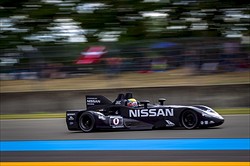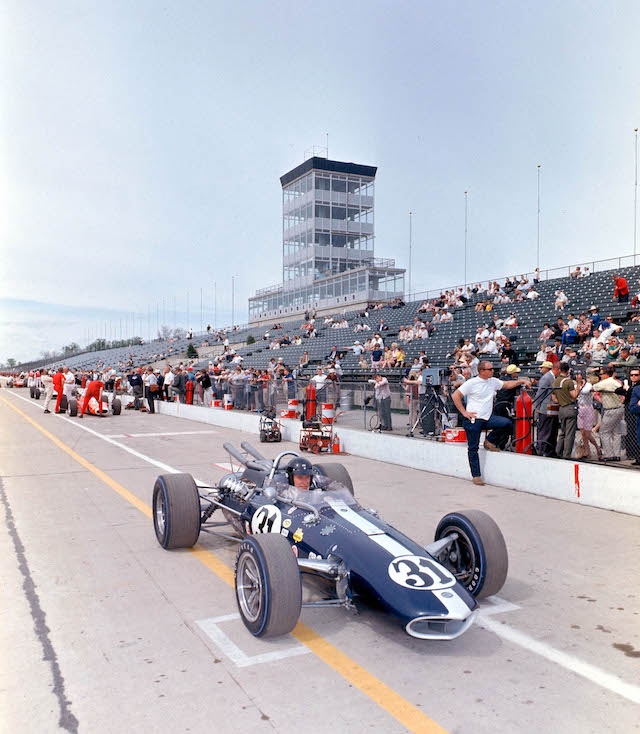FUMES
 Monday, June 18, 2012 at 05:26PM
Monday, June 18, 2012 at 05:26PM June 20, 2012
The impact of the DeltaWing will reverberate throughout the racing world long after Le Mans.
By Peter M. De Lorenzo
(Posted 6/18, 5:30 p.m.) Detroit. Though retired six hours and fifteen minutes into the race after being punted off of the track by one of the Toyota prototypes, the Nissan DeltaWing served notice that its design mantra of half the weight, half the horsepower and half the aerodynamic drag of a typical prototype met or exceeded all expectations. The significantly lower tire and fuel consumption was evident as well, with the DeltaWing able to go longer between fuel stops and do quadruple stints on its advanced Michelin tires. The DeltaWing racer completed 11-lap stints with speed on par with the LMP2 machines, despite only having a 40-liter fuel tank and 300 horsepower. A very impressive debut by any measure.
Saying that, it's important to talk about what the DeltaWing really represents, beyond its dramatic looks at any rate.
First and foremost Ben Bowlby's brilliant design vision, which was brought to life in the DeltaWing, should have a lingering impact throughout the racing world for years to come, that is if the powers that be in the various racing series can extricate themselves from the prevailing lemming mentality brought on by spec car racing long enough to make a real difference in the sport. (One place where the DeltaWing absolutely should be allowed to compete - albeit with more horsepower - is at the Indianapolis Motor Speedway.)
As I've stated many times in this column over the years, spec racing is and has been the scourge of the sport. Since the racing world began playing the spec racing game many, many years ago the sport has devolved into a tedious dance of pulling back instead of pushing forward, and it has suffered immeasurably because of it. Yes, the original idea behind spec racing had merit - for all of ten minutes or so - because remember, at the time it was a reaction to a growing concern about the overall safety of the sport, as well as cost. But the sport outgrew that rationale long ago.
Fortunately the safety aspect of the sport has come a long, long way. Some of it, unfortunately, due to racing tragedies, which then forced the issue, but there's no doubt that developments in car design, track design, advanced materials and overall driver safety have improved the sport exponentially over the years.
But the cost issue? Not so much.
Let's face it, folks. Racing is a game of the haves vs. the have-nots. It has been that way since the first car race - when you can be certain that one competitor was probably pissed-off at a perceived advantage or a trick part enjoyed by the other competitor - and it will always be that way. Spec racing keeps costs down on paper - at least initially - but ultimately deeply-funded and talented racing organizations will find a way to go faster than a lesser-funded team. That's just the way it is. So to keep insisting that spec cars must continue to be the perennial panacea for the sport only serves to keep racing in a perpetual Twilight Zone, akin to running in place in a swimming pool, while treading water.
The DeltaWing not only represents a bold new vision for the sport, its overall design philosophy based on speed with efficiency should be the guiding light for motorsports in general going forward. It's about challenging the existing formula and questioning the way things are, all in the interest of going faster while being more efficient. It's about racing series around the world embracing different approaches in the interest of pushing the envelope further. And a very positive side effect of this philosophy? It will serve to generate more fan interest and most important, new fan interest, which the sport so desperately needs.
Before signing-off for this week I'd like to give some credit where credit is due on the DeltaWing project. First of all, Ben Bowlby's brilliant vision and dogged persistence with his concept should be applauded. It took a lot of guts to put his career on the line and push the DeltaWing with everything he had, but he succeeded admirably in doing so. And certainly without Chip Ganassi's initial funding and support the DeltaWing concept probably would have never seen the light of day, except for maybe in a futuristic racing car discussion in this publication, or in Racer.
The completion of the working DeltaWing prototype was all because of Dan Gurney wholeheartedly embracing Ben Bowlby's concept and enlisting his talented All American Racers crew to bring it to life (along with the financial support of Dan Panoz). A brilliant innovator and visionary in his own right, to see Dan's enthusiasm for this project in person spoke volumes about the man and his commitment to seeing DeltaWing come to fruition.
And last but certainly not least, Duncan Dayton (ably assisted by his talented crew at Highcroft Racing) single-handedly kept the DeltaWing project alive when there was absolutely no hope for it whatsoever. Duncan tirelessly canvassed interested manufacturers while conducting high-level presentation after presentation, never giving up on the concept or its potential. It was Duncan's pivotal conversation with former EVP of Nissan Americas operation and now Renault COO Carlos Tavares (a hard-core enthusiast in his own right) at last fall's Frankfurt Auto Show that tilted the deck in the DeltaWing's favor, with Tavares guiding Dayton to Nissan Europe which then became the presenting sponsor of the car at Le Mans, as well as providing the engine, which, needless to say, was key.
And, with Nissan Europe's Darren Cox guiding Nissan Europe's involvement along with the support of the visionaries at Michelin, the DeltaWing program - thanks to the around-the-clock efforts of the entire team for many, many days on end - made the show for the 80th running of the 24 Hours of Le Mans.
To all involved, the sport owes you a debt of gratitude.
My final thoughts are these: Way back when, the criticism directed toward the DeltaWing upon its introduction revolved around the notion that it was too jarring to look at and that "it wouldn't work" (as in, it wouldn't turn). In other words, it was the fear of the unknown that seemed to annoy the DeltaWing's critics the most. And that fear turned out to be grossly misguided, at best.
My biggest fear for the sport of motor racing? I'm most afraid that this sport's perennial stagnation, its deadly two-steps forward and five-back dance of mediocrity that comes with spec cars and spec thinking will ultimately lead to the ruin of the sport itself.
This sport must make way for innovation again. Exciting and even controversial concepts like the DeltaWing need to not only exist, but they must be allowed to thrive in the white-hot arena of competition.
Racing needs to press the "reset" button so that new, visionary thinking and ideas become part of motorsport again.
 (PatrickGosling/Nissan)
(PatrickGosling/Nissan)
Publisher's Note: As part of our continuing series celebrating the "Glory Days" of racing, we're proud to present another noteworthy image from the Ford Racing Archives. - PMD
 (Courtesy of the Ford Racing Archives)
(Courtesy of the Ford Racing Archives)
Indianapolis, Indiana, 1966. Dan Gurney leaves the pits in the first Indy Eagle at the Indianapolis Motor Speedway for practice in that year's Indianapolis 500. A Len Terry design based on the 1965 Indy-winning Lotus 38, Gurney's beautiful-looking Eagle was powered by the Ford DOHC Indy V8 and built by his own company, All American Racers. Gurney entered cars for Lloyd Ruby, Joe Leonard, and himself at The Speedway that year. He also sold two Eagles to customers that were driven by Jerry Grant and Roger McCluskey. None of the Eagles completed the 200 laps, although Ruby was a contender until a cam cover leak put him out of the race with 30 laps to go. Graham Hill (No. 24 John Mecom American Red Ball Lola-Ford) won that year followed by Jim Clark (No. 19 Team Lotus STP Gas Treatment Lotus-Ford) and Jim McElreath in the No. 3 John ZInk Moore-Ford. McCluskey would later become the first driver to achieve a victory in an Indy Eagle at Langhorne, Pennsylvania that same year.
Publisher's Note: Like these Ford racing photos? Check out www.fordimages.com. Be forewarned, however, because you won't be able to go there and not order something. - PMD
See another live episode of "Autoline After Hours" with hosts John McElroy, from Autoline Detroit, and Peter De Lorenzo, The Autoextremist, and guests this Thursday evening, at 7:00PM EDT at www.autolinedetroit.tv.
By the way, if you'd like to subscribe to the Autoline After Hours podcasts, click on the following links:
Subscribe via iTunes:
http://itunes.apple.com/WebObjects/MZStore.woa/wa/viewPodcast?id=311421319
Subscribe via RSS:
http://www.autolinedetroit.tv/podcasts/feeds/afterhours-audio.xml





